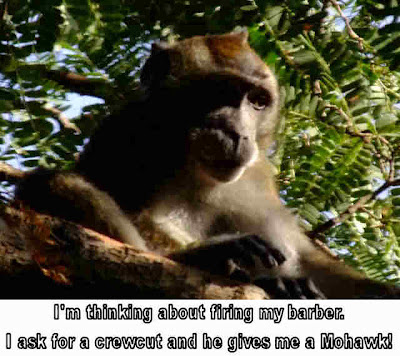We're going to let you in on a little secret: if you want to see monkeys on Corregidor, there is no better place than around our house. It's still referred to as the "Aviary House." Apparently lack Of funds led to the aviary's closure.
However, we've begun to refer to it as the "Monkeyary House." Just about any time of day and often during the night you can hear monkeys near it. We originally thought that a lot of the sounds we were hearing were from monkeys when in fact we now know they were bird noises. Once in a while a baby monkey will make a sound something like a chipmunk, but most sounds like that are birdcalls. For the most part what we are listening for are grunts, something like a pig makes, or barking sounds almost like some dogs make. Once you get used to them the sounds are unmistakably monkeys. And even if they keep their mouths shut, you will hear them when they jump from one tree to another. They can walk very quietly along a branch, but when they jump, the sound of the rustling branches will draw your attention, and you will see a branch swing up and down as it absorbs the monkey's weight.
Oftentimes we will be sitting on the front stoop reading or eating and monkeys will be crossing the road, either walking over it or swinging above through the trees, to get to the tamarind tree. When they are done, they will begin their trek back, then go from tree to tree past our solar system, and eventually end up behind the bodega, where we store our tools. If they are not in the backyard, they might be by the decrepit 3 million gallon water tank behind the old butterfly garden.
Chances are you won't have to wait too long to see them. If they are so inclined, they will sit in the trees and let you take their pictures, usually at a very safe distance. Once in a while one will be bolder, but you have to be lucky to get a good picture. First of all, they are usually in the trees and your camera will have a hard time focusing on the monkeys and not the branches. Also, the backlighting often makes it difficult to capture anything more than a silhouette.
When you do get lucky, however, it makes all the time you spend taking bad pictures worth it. We're especially thankful for digital cameras because on the days when the monkeys are hardest to shoot, you can just delete all the pictures. Even on good days most of the pictures are not worth much, since the monkey is out of focus, the lighting is bad, or he just moved when you pressed the shutter. You don't really know until you load them on the computer and take a close look, and most pictures will have to be cropped to see them well.
We'll let you in on another secret. We've learned that if you listen very closely, you can sometimes hear what they are saying. We've attached several pictures that we've taken, all within 250 feet of our house, along with what we think they were saying at the time we took them.
On Corregidor the monkeys have been known to wait until the tour bus is temporarily empty, put on a cap, wait for the visitors to re-board, and pretend to be tour guides. These pictures will give you an idea just how smart monkeys are. We'll bet that you didn't know that they like to watch golf tournaments; they get free seats in the trees, after all. You will probably be surprised to find out that they enjoy Italian operas, love Laurel and Hardy, and ponder the mysteries of the universe.





















No comments:
Post a Comment